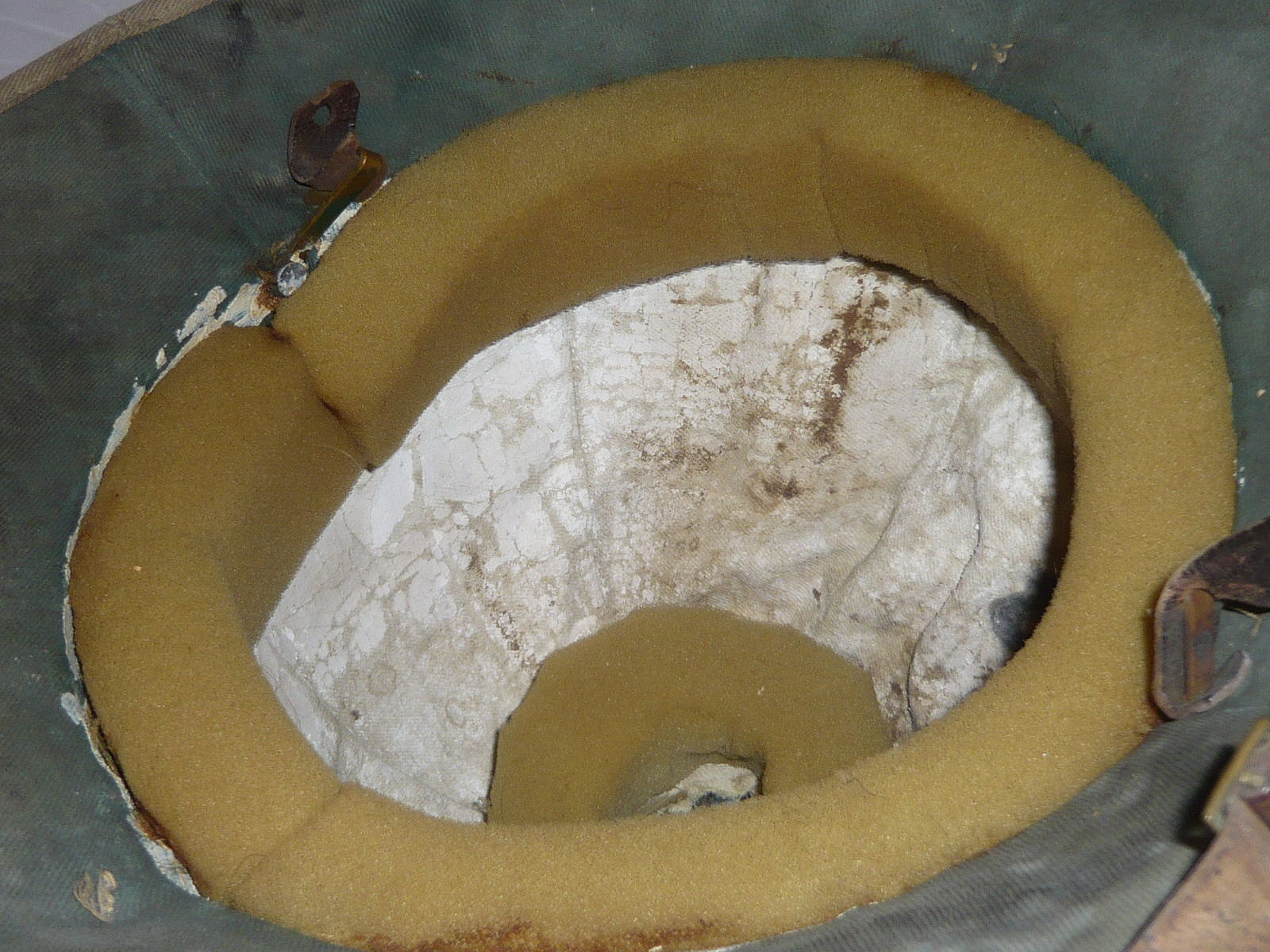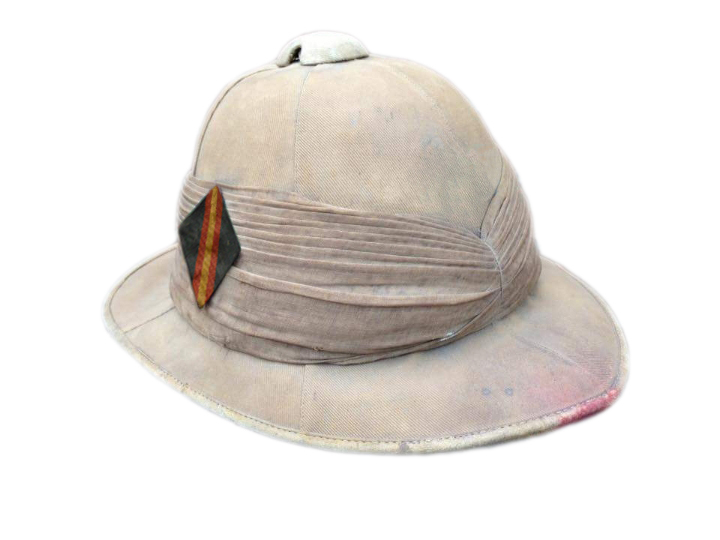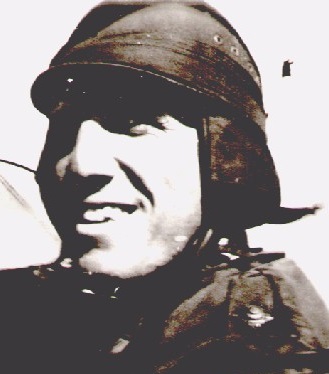 Figure 1. August 1918. The earliest close-up image found of the ‘Cork Aviation Helmet’, taken at the Royal Flying Corps/Royal Air Force, Flying School, Ismailia, Egypt, worn by Second Lieutenant Spaulding. This is the RFC 1917 Pattern, ‘Helmet, Cork Aviation’, externally the main shell is near identical to later versions, with puggaree, four side vents and a typical ‘sun helmet’ ventilation gap between the headband and shell. The outer covering at this time was made-up of four segments of cloth, a front and side seam can just be made out. A large rear brim can be seen shading the neck; however it has a very narrow and thin front peak, at this time these peaks were not part of the cork shell but were attached to the canvas cover. Soon, at least by mid-1919, the design was ‘revised’, adding a complete brim and extending the front peak slightly to help shade the face. After a 1926-27 review the liner and earflap fixings were also modified; it stayed in that configuration up to 1942. The ear-pockets can be seen to be holding large diameter gosport tube earpieces. (Image, see here). Continue reading
Figure 1. August 1918. The earliest close-up image found of the ‘Cork Aviation Helmet’, taken at the Royal Flying Corps/Royal Air Force, Flying School, Ismailia, Egypt, worn by Second Lieutenant Spaulding. This is the RFC 1917 Pattern, ‘Helmet, Cork Aviation’, externally the main shell is near identical to later versions, with puggaree, four side vents and a typical ‘sun helmet’ ventilation gap between the headband and shell. The outer covering at this time was made-up of four segments of cloth, a front and side seam can just be made out. A large rear brim can be seen shading the neck; however it has a very narrow and thin front peak, at this time these peaks were not part of the cork shell but were attached to the canvas cover. Soon, at least by mid-1919, the design was ‘revised’, adding a complete brim and extending the front peak slightly to help shade the face. After a 1926-27 review the liner and earflap fixings were also modified; it stayed in that configuration up to 1942. The ear-pockets can be seen to be holding large diameter gosport tube earpieces. (Image, see here). Continue reading
Category Archives: Middle East
The Flying Sun Helmets
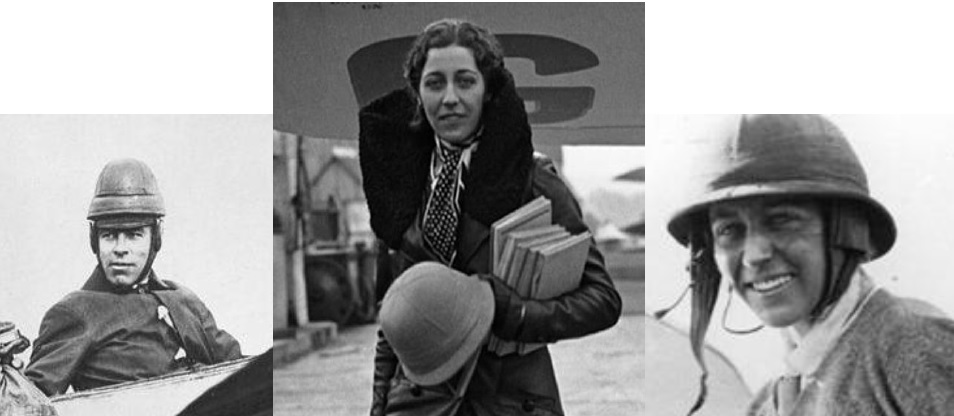 Discussed here are two types of ‘Flying Sun Helmet’; first, a type of cork crash helmet, which used Colonial Helmet construction methods, but whose primary function was protection from impacts rather than the sun, and secondly a true hybrid sun helmet, whose inception was to protect against the sun whilst flying in exposed cockpits in areas where such hats were traditionally used.
Discussed here are two types of ‘Flying Sun Helmet’; first, a type of cork crash helmet, which used Colonial Helmet construction methods, but whose primary function was protection from impacts rather than the sun, and secondly a true hybrid sun helmet, whose inception was to protect against the sun whilst flying in exposed cockpits in areas where such hats were traditionally used.
Although the early 1920s to early 1940s ‘Cork Helmet-Aviation’ (a.k.a., ‘RAF Type-A Flying helmet’ or ‘East of Malta Helmet’) is the best known aviator’s sun helmet, with various examples having been covered on this site by Peter Suciu and Roland Gruschka (Refs. 1 & 2), some earlier flying helmets also owe their origins or construction methods to military sun helmets. Continue reading
The Ugly Duckling Or The Transformation Into a Beautiful Bird – With A Name.
The helmet described in this article had been on offer on a certain internet auction platform at the UK for at least two years, headlined as “Vintage Pith Helmet World War 1 WW1 British Army First Please see photo” – The seller´s hint to see the photo first made sense: Many collectors probably have clicked to open the page and closed it immediately after having seen a helmet, filled with yellow foam – besides being offered at a price that was anything but a bargain. Continue reading
Thomas, L, Cpl, DCM, Royal Berkshire Yeomanry
Cpl Thomas was born in the Parish of Thicket, Near the Town of Wantage, County Berkshire in 1895. His occupation was given as “Farmer.”
He joined the Berkshire Yeomanry prior to WWI in 1914 having bought himself out of the Royal Horse Artillery on the 3rd of March 1914. Continue reading
Polish Sun Helmets of World War II
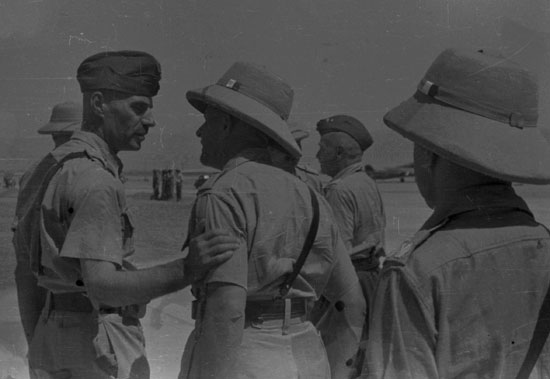
As we have previously noted many nations that had no colonial empires had soldiers don sun/pith helmets at various times. One of the more unique examples of this is Poland – a nation that didn’t even exist as an independent land for almost 150 years.
After achieving independence in 1918 and fending off an invasion by the Soviets in 1920 the nation of Poland was again occupied by invaders again in 1939. With the nation occupied by the Germans – as well as the eastern portion of the nation essentially annexed by the Soviet Union – many Poles fled to Great Britain to continue the fight to liberate their nation. The terms of the Allied Forces Act 1940, which was an Act of Parliament passed in late 1940, gave legal authority for the recognized sovereign governments of Belgium, Czechoslovakia, the Netherlands, Norway and Poland – all of which were under German occupation – to raise, equip and maintain independent armed forces on British soil.
These Polish soldiers eventually formed the 3rd Carpathian Rifle Division, and headed to the Middle East where they joined Free French soldiers in liberating pro-Vichy French Syria and Lebanon. This Division later served with General Montgomery’s Eight Army in North Africa, and throughout this campaign was outfitted in British tropical uniforms and sun helmets.
Headdress of the Transjordan Frontier Force
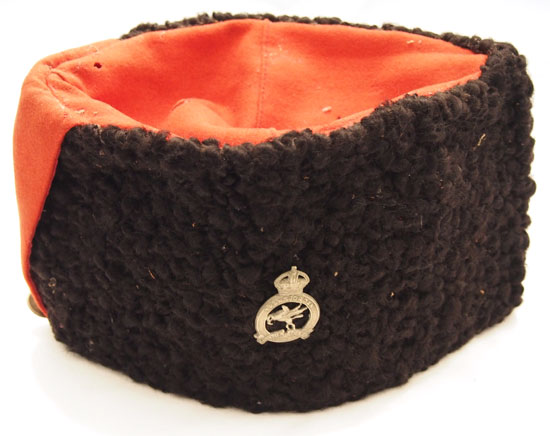
Formed in April 1926 as a para-military border guard to defend the northern and southern borders of the Transjordan, this unit was also an Imperial Service regiment. It drew its cadre from the Arab Legion, and replaced the disbanded British Gendarmerie, which itself had been founded following World War I to protect Transjordan. The unit was led by British officers, who typically donned sun helmets or visor caps – while the locally raised troops wore the Ottoman-styled kalpak, a type of headdress that was also worn by the Palestine Police Force and Arab Legion. Continue reading
Israeli Army ‘Hitelmacher’ Hat
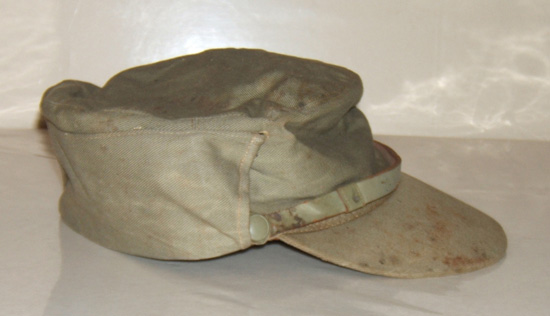
Side view of the Hitelmacher. Even more appealing when it retains a straight shape. (Collection of Alex Ben-Arieh/Historama.com)
Though the Israeli Army earned glory on the battlefield in 1948, it came into being during a period where militaria started to lose its national uniqueness. Under the influence of Eastern and Western alliances, and more efficient production processes, armies began to adopt homogeneous, if boring, accessories and equipment such as mass-made nylon patches, conventional uniforms and plain, generic helmets.
During the 1947-49 War of Independence, the Israeli Defense Forces (IDF) and its forerunners sported ‘sock hats’ (“Kova Gerev” – in Hebrew) from local manufacture or leftover British Army stocks. However the army also succeeded in receiving a uniquely styled hat in sufficient quantities that its presence also left its mark on the identity of the army: the ‘Hitelmacher’ hat. The Hitelmacher bears a semblance to a kepi in the style of a Finmark hat, but when affixed with the Army’s emblem, it also exhibits a ceremonial elegance.

